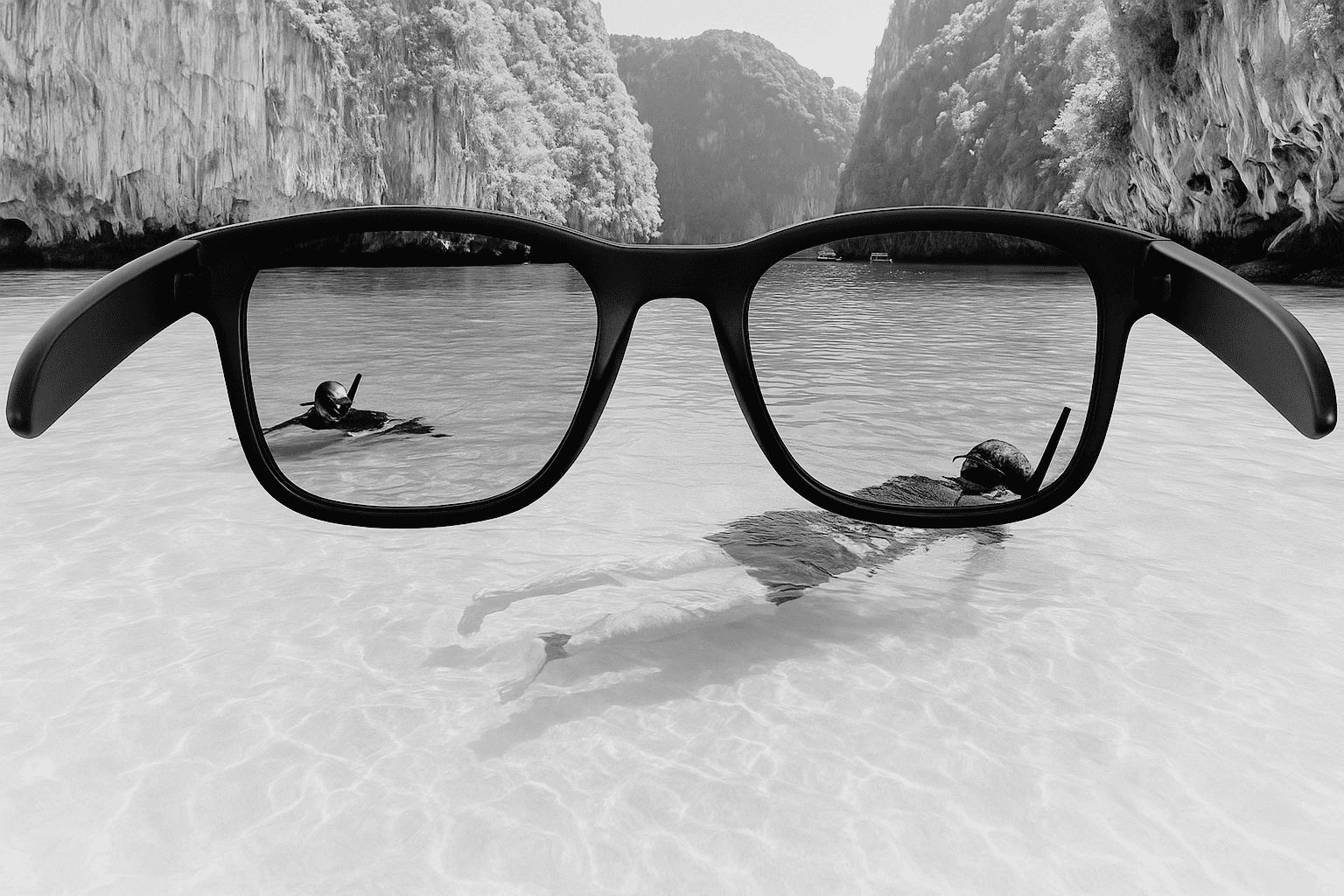Sunlight reflecting off roads, snow, or water can make it hard to see clearly—even with regular sunglasses. That sharp, horizontal glare is more than just annoying; it can strain your eyes and reduce visibility, especially in bright outdoor conditions.
Polarized sunglasses are designed to reduce that glare. But what exactly makes them different from other lenses? How do they work? And are they something you really need?
This article walks through the basics: how polarization works, how to tell if your sunglasses are polarized, and when they’re most useful—whether you’re driving across town or spending a day by the lake.
What Are Polarized Sunglasses?
At first glance, polarized sunglasses look just like any other tinted lenses. But they’re designed to do more than simply dim bright light.
These lenses include a special filter that blocks horizontal light waves—the kind that bounce off flat surfaces like roads, water, or snow. This helps reduce glare, making it easier to see clearly in situations where regular sunglasses might fall short.
It’s worth noting that polarization isn’t the same as UV protection. UV protection shields your eyes from harmful ultraviolet rays, while polarization specifically targets glare. Some lenses offer one without the other, but ideally, you want both for the best comfort and eye health.
If you’ve ever found yourself squinting behind your sunglasses or struggling to see past windshield reflections, polarized lenses might be worth considering.
How Do Polarized Sunglasses Work?
Sunlight travels in all directions, but when it reflects off flat surfaces like water, roads, or snow, it tends to bounce back in a horizontal direction. That’s what creates glare—a bright, often blinding light that can make it hard to see.
Polarized lenses are designed to block this kind of glare. They have a special filter that only allows vertical light to pass through. Think of it like turning down the brightness on just the harsh parts of sunlight.
What You’ll Notice with Polarized Lenses:
Glare from water, pavement, or car hoods is reduced
Colors look deeper and more vivid
It’s easier to see clearly in bright conditions
Are There Any Downsides?
One thing to keep in mind: polarized lenses can make it harder to see some digital screens—like phones, gas pumps, or car dashboards—depending on the angle. This isn’t a flaw, just a result of how the lenses interact with the screen’s light.
For most outdoor situations, though, the added comfort and visibility make polarized lenses a helpful upgrade.
How to Tell If Your Sunglasses Are Polarized
If you are unsure whether your sunglasses are actually polarized, here are two easy ways to check—no special tools required.
1. The Phone Screen Tilt Test
Most LCD screens (like your smartphone) emit light in a specific direction, which makes them perfect for testing polarized lenses.
Steps:
Put on your sunglasses
Turn your phone screen on and hold it in front of you
Slowly rotate the phone sideways (clockwise or counterclockwise)
What you’ll see: If your lenses are polarized, the screen will darken or show rainbow-like patterns at certain angles. If there’s no change, they’re likely not polarized.
2. Reflection Test on Water, Glass, or Asphalt
Stand near a reflective surface—like a car windshield, wet pavement, or a lake.
With polarized lenses:
You’ll notice a significant reduction in glare
Reflections may almost disappear, making it easier to see what’s underneath
These quick tests can tell you a lot. And if you’re still unsure, feel free to stop by Chinook Optical—we’re happy to check for you.
Do I Need Polarized Sunglasses?
It depends on how (and where) you spend your time outdoors. Polarized sunglasses aren’t for everyone—but they’re a game-changer in certain situations.
Driving
Whether you're driving through downtown Calgary or heading west with the sun reflecting off the Bow River, glare can be hard on your eyes. Sunlight bouncing off pavement, windshields, or snow can make it difficult to see clearly—and even become a safety concern.
Best for:
Daytime driving (especially around sunrise or sunset)
Long drives in bright conditions
Snowy or wet roads
Water & Outdoor Sports
If you spend time near water—fishing, kayaking, or paddleboarding—polarized lenses help cut through surface glare, making it easier to see what's beneath and reducing eye strain.
Best for:
Boating and fishing
Golfing near reflective surfaces
Lakeside camping or hiking
Snow & Mountain Activities
Glare off fresh snow can be intense, especially in Alberta’s bright winter months. Polarized lenses improve contrast and visibility whether you're on the slopes or walking through the city.
Best for:
Skiing and snowboarding
Winter driving
Walking on snowy streets
Everyday Wear
Even day-to-day activities—like walking downtown or running errands—can involve glare from glass buildings, cars, or sidewalks. If you're sensitive to light, polarized lenses can make things a lot more comfortable.
Good for:
People who are light-sensitive
Urban areas with lots of reflective surfaces
General visual comfort and clarity
When Polarized Lenses May Not Be Ideal
Pilots: Polarization can interfere with reading cockpit instruments
LCD Screens: Some car dashboards, ATMs, and phones may appear distorted
Night Driving: Polarized lenses reduce overall brightness—best avoided at night
A Note on Calgary: With so many sunny days, bright snow, and reflective surfaces throughout the year, many people here find that polarized sunglasses aren't just helpful—they’re part of everyday life.
Choosing the Right Pair
Not all polarized sunglasses are the same. Lens color, frame style, and prescription compatibility all play a role in finding what works best for you.
Lens Tint & Color
Different lens tints filter light in specific ways—and can enhance contrast, depth, or color perception depending on your environment.
| Tint | Best For | Benefits |
|---|---|---|
| Gray | Everyday use | Neutral color, natural vision |
| Brown/Amber | Driving, hiking | Boosts contrast, performs well in mixed light |
| Green | Golf, general wear | Good contrast, minimal color distortion |
| Yellow | Low-light, snowy days | Brightens view in fog or overcast conditions |
Prescription Options
If you wear glasses, you can get polarized lenses in your prescription—whether for distance, reading, or multifocal use.
Common options include:
Single-vision
Bifocal
→ Learn more about [bifocal vs. progressive lenses]Progressive (sometimes combined with photochromic or anti-reflective coatings)
→ Learn more about [photochromic progressive lenses]
Just note: not all lens materials work with all prescriptions, especially if you need a strong correction. A qualified optician can help you choose lenses that balance clarity, weight, and durability.
Frame Fit & Coverage
For the best glare protection, look for frames that wrap slightly around your face. This helps block sunlight from entering at the sides—useful for driving, water sports, or hiking.
Comfort and fit matter, too. If a frame slips or pinches, even the best lenses won’t be much help.
Finding the Right Balance
The best polarized sunglasses are the ones that suit both your vision and your lifestyle—whether that’s weekend hikes, city errands, or long drives.
If you’re not sure where to start, a visit to a local optical shop can help you compare lens types, try different tints, and get advice based on your daily routine.
FAQs
Do polarized sunglasses block UV rays?
Not necessarily. Polarization reduces glare, while UV protection blocks harmful ultraviolet light. Make sure your lenses offer 100% UV protection.
Can kids wear polarized sunglasses?
Yes. In fact, children’s eyes are more sensitive to glare and UV. Polarized lenses are great for outdoor play, especially around water or snow.
Why do some screens look weird through polarized lenses?
LCD screens (like car dashboards, phones, or ATMs) emit polarized light too. When your lenses cross-filter it, the screen may look dark or have rainbow effects—this is normal and harmless.
Are polarized lenses good for skiing and snowboarding?
Absolutely. They reduce glare off snow and ice, improving contrast and visibility—especially on bright, bluebird days.
Should I wear polarized lenses for night driving?
No. Polarized lenses reduce overall light transmission, which can make it harder to see in low-light conditions. Stick with clear, anti-reflective lenses at night.
Let’s Find the Right Fit Together
Whether you're dealing with snow glare in winter or sunlight bouncing off water in summer, polarized sunglasses can make everyday outdoor activities more comfortable. They help reduce eye strain, improve contrast, and make it easier to see in bright conditions.
If you’re considering a pair, think about when and where you’ll use them most—and what kind of lenses fit your vision needs. Trying a few in person can also help you find the right tint, fit, and frame style for your lifestyle.
And if you're not sure where to start, we're here to help. As optical professionals, we can guide you through your options and help you find what works best for your eyes—and your day-to-day life.


